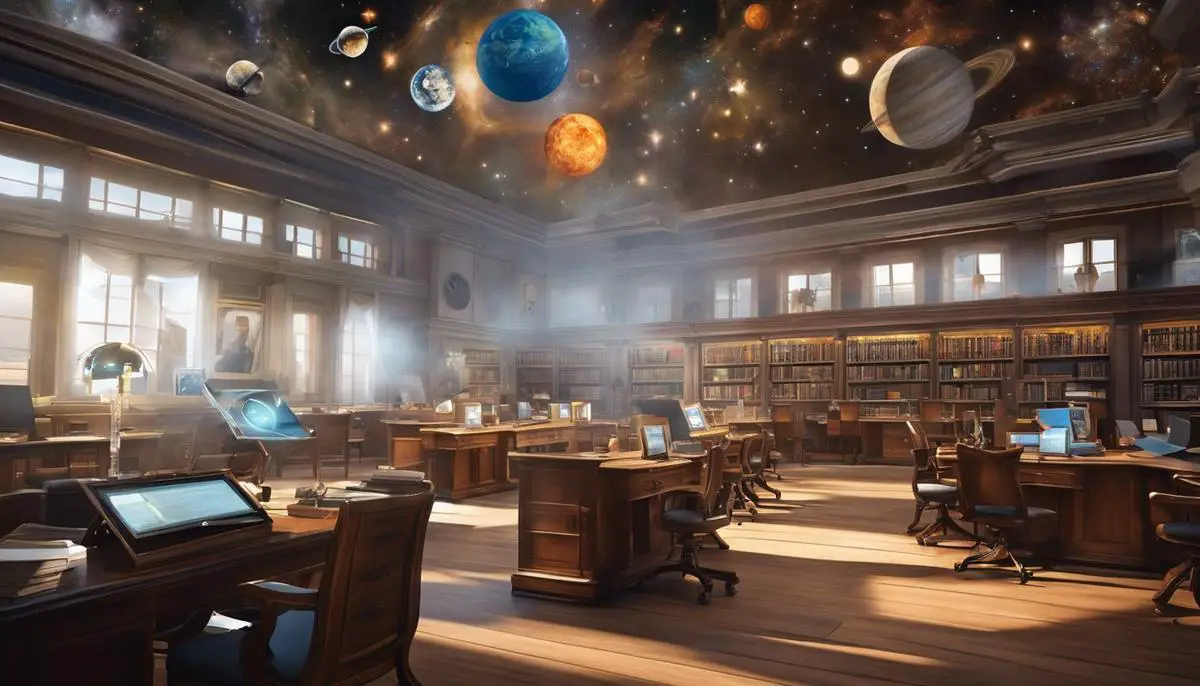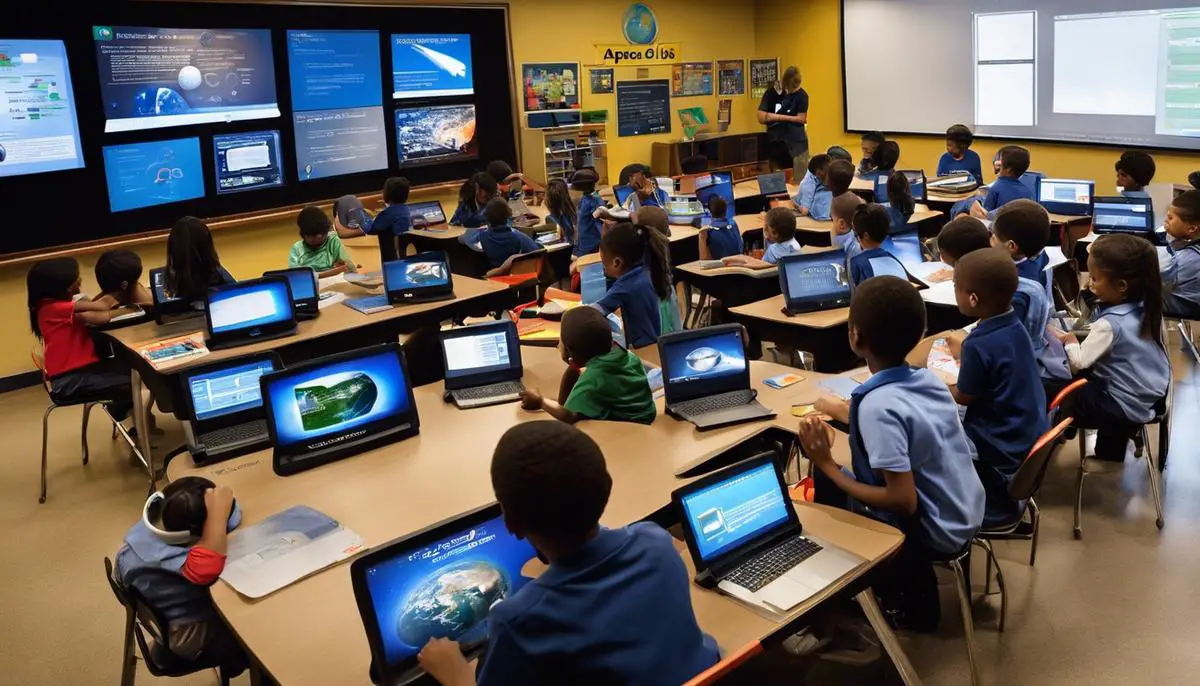The Apollo missions stand as a testament not only to human ingenuity and determination but also as a catalyst for educational evolution that has resonated through the decades. When the first humans set foot on the moon, they did more than fulfill a national goal; they ignited a spark within the realm of education that would alter its trajectory indefinitely. Schools seized upon the surge of intrigue in space exploration and the technological marvels of the era, prompting a significant shift in focus towards Science, Technology, Engineering, and Mathematics (STEM). This paradigm shift was not merely in response to a newfound fascination with the cosmos; it was a strategic pivot aimed at empowering the next generation with the aptitude to lead in an increasingly tech-driven world. The resonating influence of the Apollo saga in educational spheres continues to bear fruit, as we explore the ensuing renaissance in STEM education, the integration of Apollo era technologies into learning environments, the inspirational figures emerging from the space program, and the cultural waves that have fortified the structure of educational policy and enthusiasm for learning since that monumental era.
Contents
Shifts in Educational Focus Post-Apollo
Blast Off to Learning: How Apollo Steered Education into a New Orbit
Ever gazed up at the night sky and felt inspired by the twinkling stars? That curiosity is precisely what the Apollo missions ignited across the globe. When astronauts first landed on the moon, it wasn’t just one giant leap for mankind; it transformed how we approach learning and prioritize education.
In the wake of the Apollo successes, the world quickly realized the importance of science, technology, engineering, and math (STEM) in schools. Suddenly, every budding astronaut wanted to know more about the vast universe. Classrooms everywhere buzzed with the possibilities of space exploration and the untapped potential of human innovation.
Already savvy in your ABCs and 123s? Apollo missions said, “Think bigger!” Math geeks and science nerds became the new cool kids, with telescopes and microscopes as must-have accessories. Education programs received more funding to ensure that the next generation could reach for the stars – literally. Robotics clubs, computer coding classes, and even space camps popped up, making tech-savvy education the norm.
The space race also taught us that looking good and dream-chasing go hand-in-hand. The sleek, futuristic design of space gear influenced style on the runway. Minimalistic designs and metallic finishes in fashion still ooze that cosmic coolness. It’s simply star-studded to merge functionality and aesthetics, mirroring the innovative spirit of the Apollo era.
So as we salute these space pioneers, let’s not forget the educational revolution they sparked. From upping our tech game to cementing the cool factor of STEM, the Apollo missions set us on a course for an ever-expanding universe of knowledge. Now, let’s all be space explorers in our way, rocketing towards a future filled with discovery and style, one stellar lesson at a time.

Apollo Technology in the Classroom
From Lunar Landings to Learning Lift-Off: Apollo Tech in Today’s Classrooms
Imagine a world where school kids get to play with tech that was once used to propel astronauts to the moon. Far out, right? Well, guess what, it’s not a sci-fi fantasy, it’s the classroom of the here and now. Schools are seriously upping their game by using technology that can trace its roots back to the groundbreaking Apollo missions.
Engage with this: interactive simulation software. This genius bit of programming lets students experience what it’s like to navigate through space. These simulators were born from the technology that trained Apollo astronauts for their cosmic voyages. Now they’re helping kids understand complex concepts in physics, like how gravity works (or doesn’t!) in space. They’re not just learning; they’re virtually stepping into Neil Armstrong’s moon boots!
And that’s not all. Did you know that the materials developed for astronaut space suits are now being used in robotics? Yep, you heard that right. Those slick, protective layers designed to handle the brutal environment of space are now being mimicked in robotics kits. These classroom robots endure plenty of wear and tear while they help students learn about coding and technology in a fun, hands-on way.
Then there’s the small matter of those trusty laptops and tablets that are classroom staples. The revolutionary microchip and digital technology that allowed Apollo missions to succeed paved the way for the compact, powerful devices that are now the gatekeepers to a world of knowledge for students. With these gadgets, they’re not just learning history; they’re coding, creating, and connecting in ways that would have space pioneers doing a moonwalk of pride.
And let’s not forget those advanced calculators—they’re practically pocket-sized scientists! The software and tech behind these number-crunching buddies are descendants of the Apollo guidance computer, which helped navigate to the moon. Today, that same type of computing power is helping students solve algebra, geometry, and even calculus problems. Math class just got a whole lot cooler.
So go ahead, give a nod to the Apollo missions the next time you see a kid expertly presenting a project on the solar system or coding their first game. The cutting edge of space exploration has brought the excitement and discovery of the final frontier right into today’s classrooms, encouraging the innovators of tomorrow. Blast off to learning has never been so thrilling!

Inspirational Figures and Curriculum
Shooting for the Stars: How Apollo-era Icons Revolutionized Learning Content
Hey, style mavens and forward-thinkers! Ever wonder how the dazzling world of Apollo astonauts from decades past still fuels our learning today? Well, the journey to the moon didn’t just leave footprints on its surface, it also rocket-launched a cosmic shift in the content we find in today’s classrooms.
Let’s dial back to the era of astronauts becoming household names, where the likes of Neil Armstrong and Buzz Aldrin were not just exploring space but pioneering paths in education.
As we dig deeper, it’s clear how textbook content got a stellar upgrade. Imagine flipping open a science book from before the moon landing—yawn, right? But post-Apollo, those same books leapt to life with gripping details of space missions and the brave astronauts who turned science fiction into science fact. The ripple effect? An instant cool factor for subjects that were gathering dust bunnies before.
The iconography of mission patches and the undeniable allure of the NASA logo sparked imaginations worldwide. Lesson plans started featuring these symbols of human achievement, engaging students in a way that was as fresh as the latest runway collections. That’s the power of branding, even in education!
Space talk didn’t just orbit around in science class, either. It permeated into the arts and humanities, influencing culture and stirring discussions from the profound implications of space travel to the ethical considerations of exploring the final frontier.
Remember the black-and-white photos of Mission Control? Those intense scenes of Apollo experts evaluating data became a hot visual for math teachers aiming to show real-world problem-solving. Math was no longer just numbers on a page; it was the lifeline of astronauts thousands of miles from home.
And what about those captivating televised broadcasts from space? Education tech took cues from this, turning distant learning from a dream to an everyday convenience. If one could transmit a broadcast from the moon, why not a virtual classroom session?
Not to forget, the very way of learning through collaboration and interdisciplinary teamwork models the essence of what made the Apollo missions a success. Group projects, buddy systems—you name it—every initiative echoing the camaraderie of those space pioneers.
With these changes, it became clear that knowledge wasn’t just power; it was adventurous, boundary-pushing, and downright stylish. Just like the iconic figures of Apollo times, the material used to mold young minds continues to be a beacon of modernity and an endless source of inspiration.
So, here’s to the Apollo-era icons who didn’t just take one giant leap for mankind but also launched an educational revolution that’s still taking us to new heights. Keep looking up because the sky’s the limit on what one can learn when fueled by the stars!

Cultural Effects on Education
Shooting for the Stars: Apollo’s Enduring Role in Shaping Today’s Learning Scene
Ever wondered why classrooms buzz with talk of galaxies far, far away or what propels rockets into the vast cosmos? It’s quite simple: that golden era of space, the Apollo missions, left an indelible mark not just among the stars but right here, within the walls of learning institutions.
During the height of the Apollo missions, there was this unique blend of curiosity and enthusiasm that spilled over into the realm of education, and this fascination wasn’t limited to just science disciplines. The ripple effect touched everything from language arts to social studies, igniting a sort of renaissance within the school corridors.
Let’s fast forward to how Apollo continues to shape education today. Take language arts, for example. The narrative of Apollo’s odyssey is a compelling story of human determination and ingenuity. It’s spiced up language curriculums with tales that are not only historic but inspire creative expression. It’s not just about reading and writing anymore; it’s about storytelling that captures imaginations and shoots them straight to the moon.
Similarly, social studies curriculums gained a robust module that circles around the societal impact of space travel. Apollo’s adventures have become a benchmark for understanding global collaboration, the technological race, and the geopolitical climate of the past, which, in turn, provides a mirror for today’s world issues.
Even more fascinating is the manner in which gym classes took inspiration from the physical training of astronauts. Who would have thought PE could take cues from lunar astronauts bounding across the moon’s surface? Agility and strength exercises have evolved, echoing the rigorous preparations for space voyages, making fitness routines not just healthy but also ‘out-of-this-world’ exciting.
Then, there are cross-curricular projects that owe their genesis to Apollo’s times. Projects like designing a space habitat or mapping a lunar colony demand an interplay of science, mathematics, arts, and literacy skills, fostering a holistic educational approach. Schools are growing mini-mathematicians and budding biologists who also have a flair for the artistic and linguistic. It’s incredible how one space program has united different branches of learning under one sky.
Apollo did not just spark a moment of advancement and then fade away; it set the ball rolling for a continuum of transformation. Now, every leap in technology and innovation in education systems is, in some way, benchmarked against the heady days of lunar exploration. It serves as a perpetual reminder that learning is infinite, just like the universe, and that one giant leap can lead to millions of footsteps on the ground, shaping minds and future perspectives.
In sum, the commitment to education seen during the Apollo years wasn’t a transient shooting star. It was more like a comet that comes around again and again, reminding us of the importance of reaching high and pushing the boundaries. Apollo, the antique god of knowledge, would be proud to see his namesake continuing to enlighten the path of education today.

Reflecting on the journey from the launch pads of the Apollo missions to the tech-enriched classrooms of today, the enduring impact on education stands clear. The lunar legacy encompasses far more than the artifacts and moon rocks that lay silent witnesses to human exploration; it is etched in the very fabric of our educational institutions and the infinite curiosity of students who dare to dream. As educators and stewards of knowledge, we are tasked with maintaining this spark of inspiration and endeavoring to push the boundaries of our curricula, just as the Apollo astronauts once pushed the boundaries of what humanity believed to be possible. We foster this legacy whenever we encourage a child to wonder about the stars or explore the potentials of technology, ensuring the flames of discovery and innovation ignited by the Apollo missions continue to burn brightly in the hearts and minds of future pioneers.
